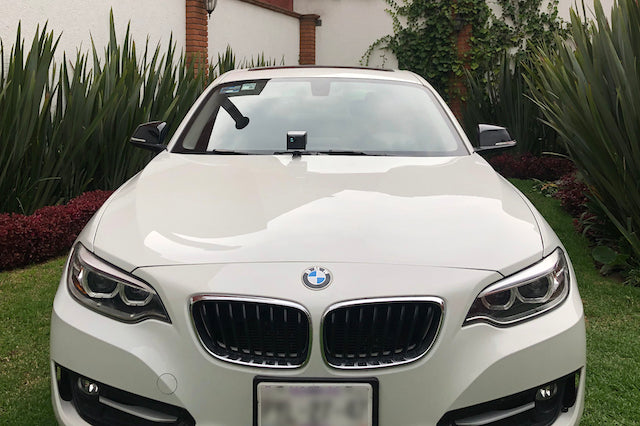There are two different kinds of dash cameras that help you see the road better at night:
- Night vision cameras
- Thermal imaging cameras
In this comparison guide, you'll learn more about each type of dash cam and explore the pros and cons of each one.
What is a Night Vision Camera?
A night vision camera is basically a light amplifier. It takes the visible light and then makes it brighter. A night vision camera only works when there's some light. When the conditions are just right, you'll get a camera feed that's similar to this:

(A screencap of a road cam in New York)
What is a Thermal Imaging Camera?
A thermal imaging camera is actually a sensor, but it functions like a camera. It detects very small differences in temperature between surfaces, and then use that information to create a picture of the world that's similar to this:
Night Vision Cameras: Pros and Cons
Night vision cameras exist because they sort of work. Let's talk about the upsides and downsides of owning a night vision camera.
Pros
- Night vision cameras can be inexpensive. A night vision camera will set you back $50-$500, depending on the brand and model. However, keep in mind that a cheap night vision camera might not work as well as a more expensive one.
- Night vision cameras provide a pretty natural image. When the conditions are just right (more on this later), night vision cameras provide a pretty clear and sharp image.
- The battery life on night vision cameras can be long. It depends on the brand and model, of course. Having a battery-powered camera on your dash means you would need to keep spare batteries in your car in case your camera battery dies on the road, though.
Cons
- Night vision cameras only work when there's at least some light in the sky. If it's a moonless night, or if there's cloud cover, night vision doesn't work very well.
- Night vision cameras don't work when it's too bright. That's why night vision cameras don't work during the day.
- Night vision cameras can't see through obstacles like trees, fences, or bushes. If there's an animal hiding behind a bush on the side of the road, for example, your night vision camera can't detect it. If that animal decides to dart out onto the road in front of your car, your night vision camera may finally detect it but it'll be too late.
- Night vision cameras don't work in dusty, foggy, or smoky conditions. Dust, fog, or smoke will obscure the image.
In a nutshell, night vision cameras only work on clear nights with some moonlight, and when you're driving on a road without a lot of obstacles. If you're not in the "Goldilocks zone", your night vision camera is pretty much useless.
Thermal Imaging Cameras: Pros and Cons
How do thermal imaging cameras stack up against night vision cameras? Let's find out!
Pros
- Thermal imaging cameras work in just about any situation. Because thermal imaging cameras don't rely on visible light, they work in just about any situation -- foggy weather, dusty conditions, complete darkness, you name it.
- Thermal imaging cameras can see through obstacles. Because thermal imaging systems pick up temperatures, they come with "x-ray vision". If there's an animal hiding behind a tree on the side of the road, your thermal imaging camera can detect its body temperature. The sames goes for someone hiding behind a fence or in the bushes on your property.
- Thermal imaging cameras can track residual heat. Not only can thermal imaging cameras detect living beings, but they can also detect the footprints and handprints recently left behind by a person or animal. This comes in especially useful when hiking, looking for a lost pet, etc.
Cons
- Thermal imaging cameras cost a little bit more upfront. However, you get what you pay for. Since thermal imaging cameras detect a lot more than night vision cameras, they prevent a lot more costly accidents.
The Verdict

Despite the advantages night vision cameras offer, the conditions have to be just right for you to be able to use one. It has to be dark outside, but not too dark. The road in front of you also has to be clear of fog, dust, and obstacles for the night vision camera to be able to register anything. Since the best time to use a night vision or thermal imaging camera is when visibility is low or there's a lot of obstacles on the road, you can't really count on a night vision camera when you need it the most.
Thermal imaging cameras are more reliable at night, even in adverse conditions. If you want a dash camera that will help increase visibility at night, a thermal imaging camera is just what you need. To learn more about thermal imaging cameras and how they work, check out the following resources:

